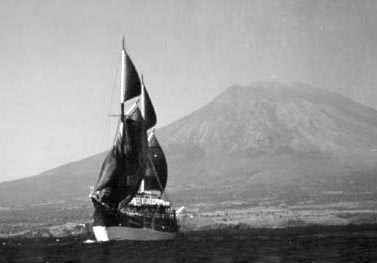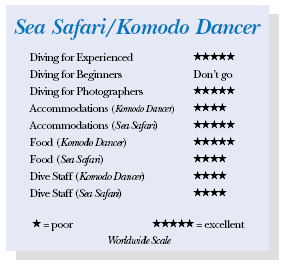Komodo Liveaboards, IndonesiaContents of this Issue: Hartford Insurance Tries to Stiff Diverís Widow Study Finds Diving May Damage Your Lungs The Diverís Alert Network Saga Travel Safety in the Age of Terrorism More About Those Medical Exams Why Divers Die, Part III: are you rusty? Editorial Office: Ben Davison Publisher and Editor Undercurrent 3020 Bridgeway, Suite 102 Sausalito, CA 94965 can it get any better? from the February, 2003 issue of Undercurrent
Dear Fellow Diver: Indonesiaís Komodo Islands have legendary diving, but until just a few years ago, one was faced with selecting from primitive and barely seaworthy boats, amateur dive facilities, lousy food, and spartan accommodations. While I once took a certain smug pride in tolerating substandard boats and living conditions to get to the most remote sites, my enthusiasm for roughing it has been tempered with age. So, while Iíve been fortunate to dive the world, I waited for the certainty that a quality liveaboard would eventually operate wherever the diving reality actually intersects with the promotional hype. So last May and June I took back-toback trips on the two 21st-century liveaboards for an incomparable, once-in-a-lifetime diving experience. In 2000, Kararu Dive Voyages began operating the Sea Safari III, a 120-foot vessel constructed along the traditional lines of a local Pinisi schooner, a substantial craft built from local hardwoods. Though tricked out with sails from two masts, itís primarily propelled by a reliable diesel engine at a comfortable nine to eleven knots. Because of the craftís swashbuckling romanticism, with tall masts and old world cache, I wouldnít have been surprised to find Captain Hook looking down from the rigging. The vesselís massive beam -- nearly 30 feet at its
widest -- provides both stability and comfort. While there
are 12 double staterooms, only 16 passengers are booked at a
time. The staterooms are huge by comparison to other liveaboards,
twice that of the average Aggressor cabin. Thereís plenty of space for privacy without having to hole up in a stateroom. The spacious main salon has several large dining tables. A starboard lounge is dedicated to viewing diving videos or movies and relaxing. I enjoyed the excellent library of diving reference books, as well as esoteric videos including the documentary ďRing of Fire,Ē which chronicles exploration of Indonesia by a pair of British would-be anthropologists. Aft on the third deck is a massive outdoor lounge protected by a sun awning and furnished with comfortable Balinese couches and chairs. Even during the hottest days, sea breezes cooled this area. Up a short flight of stairs is a sun deck with lounges and a bar. Forward on the primary deck is the spacious diving center. Individual lockers have loads of room for storage and thereís ample space for hanging wet suits and skins. The port-side deck has separate lockers and a large counter devoted to camera and video equipment, but it can get crowded when everyone on board is a photographer. On-board film processing was available, and the service and quality were excellent. Kararu is owned by three young partners who each take trip shifts to oversee the operation. On my 12-day voyage, partner Rhodes, an affable ex-pat Brit who spent many years in the diving business in Bali, looked after the 17 diving guests while supervising an Indonesian crew of nearly 20. We dived from two 20-foot aluminum launches with outboards. While crowded when full of photographers, the crew did a great job handling the load and caring for cameras. Typically, Rhodes and another divemaster accompanied each dive, while at least one crew member attended to pickups. Most sites were only five minutes from the main ship. Since my trip, Tony has replaced the original launches with larger, faster, and more spacious fiberglass boats. And former Texan Larry Smith, a legendary fellow who enjoys a reputation as Indonesiaís premier diver professional, joins the crew occasionally. They serve meals in the air-conditioned main salon. The fare is mostly Indonesian with a preponderance of spicy sauces, curries, and plenty of rice. I loved the food and eagerly awaited the next special entrťe, but then Iíve got a fondness for curry. You wonít find much in the way of steak or hamburgers, and little to satisfy a strict vegetarian, but Tony says he can make reasonable food requests happen if given advance notice. The second boat is the Peter Hughes Komodo Dancer, a newly constructed Pinisi 98-foot schooner. The overall space is considerably less, so it only carries 16 guests in eight staterooms. Like Sea Safari, each stateroom has its own private head and shower and individual a/c controls. The rooms are smaller but are immaculately clean and with the extra touches guests expect from Hughesí fleet. Robes, soaps, towels, etc. are higher quality, and they give extra attention to bed turn downs at night, along with morning coffee delivery. They changed linens and towels whenever requested. Depending on the cabins, there are queen berths, twins, or upper/lowers. However, they are small. Storage is adequate, but donít leave anything lying around as it will immediately be underfoot and a nuisance. I do wish the air conditioning could have been cooler, however.
One big drawback is the lack of any real place to socialize. What would logically serve as a main salon in the main cabin was equipped with a computer, some reference books, and software programs to edit videos, and was mainly used as an office for the dive staff. A large table on the port side went unused, because the area was not air conditioned and was too hot. Comfortable furniture and climate control would go a long way toward creating a comfortable hangout. They serve meals outside on a long table mounted to the main deck, where a sun awning and plenty of chairs at the table make this the social center. Dive lockers are spread around the other areas on the main deck, along with hanging lines for suits, etc. The food was the best Iíve had on any liveaboard, and Iíve been on plenty. Although Indonesian offerings were always available, they oriented the cuisine toward western tastes. Roast beef, chicken, seafood, steak, and savory stews were among the typical fare. Each was superbly prepared and presented by an attentive wait staff. They include a full selection of wines and soft drinks as well. The alfresco dining arrangement was never too warm and on clear nights with the stars in full splendor, the setting was perfect. Guests tended to linger over dinner and drinks, and some lively storytelling resulted. Overall, a charming ambience and a doting staff make this a great experience. Diving is conducted from two fiberglass outboard launches and supervised by Gary Bevan and his personable staff. Gary, another British ex-pat, worked with Tony Rhodes before joining the Dancer. Susanna Henderks is a veteran instructor and photo pro. Indonesian Yan Alfian is the third divemaster. All three are thoroughly professional with a ďcan doĒ attitude that delivered outstanding diving at every stop. The Dancer offers Nitrox at slight extra cost, and they do TDI Nitrox certifications on board. All the dive staff ensured that each guestís interests were fully realized whether it be photography, critter spotting, or merely serving as a watchful dive partner. To dive Indonesiaís southeast islands, one must go during the dry monsoon season, June through October or November. Monsoon refers to the predominant wind pattern that affects water temperature, visibility, and the surface wave conditions. The dry monsoon should provide calm seas, high 70s to low 80s oF water, superb visibility (75-200 feet), and little rain. However, when the boats venture south less than 20 miles, expect dramatically colder waters -- low 60s, even 59oF! -- and reduced visibility, thanks to upwellings from the southern ocean, which bring nutrient- rich waters and plankton. But these cool waters around the southern end of Komodo and Rinca showcase perhaps the most incredible macro and critter populations in the world. While Kararu staff say 60oF is very uncommon, youíll need at least a 5mm suit and hood for comfort. Since both vessels berth in Baliís southeast harbor, itís at least an overnight of steaming to get to the good diving. Most itineraries include a first stop around the volcanic island of Sangeang and later Gili Banta before arriving in Komodo and the park sanctuary islands. Both islands offer macro subjects in astounding numbers. At high voltage seamounts, including ďGPS,Ē I had electric encounters with pelagics, including 6- to 8-foot reef sharks, and massive schools of tropicals all washed in brisk currents. Along Gili Bantaís protected shores, with beautiful beaches, lay superb hard coral gardens, colorful soft corals, and excellent drop offs. I could easily spend a week just exploring the richness of this one island. A short distance to the east lies Komodo, with two principal protected anchorages and a palette of small surrounding
islands. Komodo diving is simply overwhelming with a staggering variety of walls, coral gardens, sea mounts and pinnacles, drift dives, and tranquil, placid sites that challenge the photographer to shoot wide angle or macro. On some dives both systems were necessary to avoid missing once-in-a-lifetime subjects. While some sites do require a comfort level with currents and surge, plenty of locations are easy for the average diver. Itís also worth noting that the corals in the Komodo region have virtually no trace of blight or bleaching, which has affected Palau and Fiji. In fact, the diversity of corals and staggering formations of vast virgin forests and coral heads equal the best to be found anywhere in the world. Iíve been around, and more important, Iíve hit Fiji, Micronesia, Australia, the Solomons, the Red Sea -- and all within the last five years, not just in their heyday many years back. Komodo is tops on a world scale today. Both Kararu and the Komodo Dancer use excellent well-secured hotels in Baliís Sanur Beach zone to house guests. Bali is an amazing island filled with terraced rice paddies, dense jungle, exciting river rafting, ancient Hindu temples, wild monkeys and exotic birds, and spectacular beaches. I stayed in a private suite at the beautiful Pun Santrian on Sanur Beach for less than $90 a night, including breakfast and afternoon tea. In the aftermath of the October attack, many hotels have slashed their rates to attract tourists back. (See page 12 for a full report on safety.) So what boat to take? Both are captained by Indonesian masters. The Komodo Dancer lacks the sheer size of the Sea Safari. While it has two salon/ lounges and a separate sun deck/bar, the Dancer has only a small sitting area above its main deck around the pilot house. My group didnít seem to mind the lack of social spaces, in part because the food and weather were so good. Then again, they hadnít seen the alternative. The Sea Safari has ample air-conditioned public space and lounging areas, but it loses points for overall housekeeping and the perks that Peter Hughes lavishes on guests. The Dancer wins on food quality and presentation but you sacrifice a proper inside lounge and must live with smaller staterooms. Both dive staffs are excellent and the two vessels essentially ply the same routes and visit the same dive sites. With three to four dives daily (some days even five), on either boat I was free to dive however I pleased; most photographers elected to go solo. If a less than competent diver wanted to go off alone for photo purposes, a divemaster discretely shadowed him. The dive staff was always happy to accompany any diver and were expert at locating and pointing out the many special critter subjects that abound. A slight edge went to the Komodo Dancer staff, who seemed absolutely committed to seeing that everyone, photographer or not, saw the macro subjects, special gorgonians, crinoid colonies, and coral gardens. And, while they routinely check divers in and out, they make no comment about profiles or decompression status. Night dives were available nearly every night, sometimes at dusk, sometimes at dinner. My bet is that most divers will be happy on either vessel. Though Nitrox is coming to the Sea Safari, for now only the Dancer offers it. All things considered, I will return, and Iíll pick the Sea Safari, on space alone. Finally, I must add that my editor, Ben Davison, complained that my piece sounded ďtoo much like a Skin Diver piece. Canít you find anything to be critical about?Ē After I told him what he could do to himself and the horse he rode in on, I told him that both these operations do an excellent job of getting people to superior diving consistently and deserve the descriptions I have honestly offered. I am perhaps the harshest critic around and loathe over-hyped mediocre operations wherever they may be. This is a special region that is largely unvisited, up to now, by divers, and I have fairly pointed out the few negatives. Overall, these guys are doing a great job in an area where their level of quality is hard to achieve. The diving is spectacular, Ďnuff said. Ask me to review a few other liveaboards we all know, and Iíd shred them to pieces for overly restrictive dive rules, inattentive crew, so-so food, crappy boat designs, and diving that is mediocre at best. But this is some of the best diving in the world and deserves to be reported accurately. -- C.V. P.S.: Eight months after our reviewer was aboard the Dancer, a well-traveled reader, Richard Lehach, of Larchmont, N.Y., was aboard. We think itís important to conclude with his remarks, which show how boats change, chefs change, things change: Komodo has some of the best reefs I have seen for color and diversity. Some over-fishing is evident in the scarcity of large fish at some sites. On two dives in late December and early January, visibility ran a disappointing 10-15 feet; it averaged 30-50 feet and a few dives had 80-90 feet. The main salon is cramped with a full boat. Unfortunately, the salon leaked when it rained, as did four of the eight cabins. Breakfast was standard liveaboard; lunches were usually very good, but the sit-down dinners were usually on the poor side (the chef should stick with what he knows, dinners were usually more western-style dishes and inferior in quality). The Dancer left port without enough fuel and we lost a full day of diving in Komodo because we had to refuel outside Komodo. I expected 46 dives to be available on an 11-day trip (9.5 days of diving), but only 30 dives were available (a maximum of four dives on full dive days). This was a disappointment, and Peter Hughes should change the advertising if this is what is to be expected. Komodo Dancer is on the pricey side and would be worth it if the boat were in top condition and all dives advertised were delivered, unfortunately neither occurred. It is a shame because the crew was very friendly and helpful.
|

I want to get all the stories! Tell me how I can become an Undercurrent Online Member and get online access to all the articles of Undercurrent as well as thousands of first hand reports on dive operations world-wide
| Home | Online Members Area | My Account |
Login
|
Join
|
| Travel Index |
Dive Resort & Liveaboard Reviews
|
Featured Reports
|
Recent
Issues
|
Back Issues
|
|
Dive Gear
Index
|
Health/Safety Index
|
Environment & Misc.
Index
|
Seasonal Planner
|
Blogs
|
Free Articles
|
Book Picks
|
News
|
|
Special Offers
|
RSS
|
FAQ
|
About Us
|
Contact Us
|
Links
|
3020 Bridgeway, Ste 102, Sausalito, Ca 94965
All rights reserved.

 Some
have twin lower berths, others a king-sized bed. Each cabin
has a large ensuite head with a shower and toilet. Mirrors
are large, but lighting in some rooms was inferior and badly placed, making shaving something of an
adventure. Though cabins were cleaned
daily, they werenít spotless and the
linens and towels showed signs of wear,
but the owner said he was soon replacing
them. Each cabin has individual air-conditioning
controls, important in a climate
that is both hot (85-98oF) and staggeringly
humid. Kararuís vessel stayed cool and
dehumidified.
Some
have twin lower berths, others a king-sized bed. Each cabin
has a large ensuite head with a shower and toilet. Mirrors
are large, but lighting in some rooms was inferior and badly placed, making shaving something of an
adventure. Though cabins were cleaned
daily, they werenít spotless and the
linens and towels showed signs of wear,
but the owner said he was soon replacing
them. Each cabin has individual air-conditioning
controls, important in a climate
that is both hot (85-98oF) and staggeringly
humid. Kararuís vessel stayed cool and
dehumidified. 
 Here, diving meets the expectations
of the most refined critic. I was
particularly taken by the diversity of
corals and fish around both Gili Lawah
Laut and Gili Lawah Darat. A series of
tiny islets and rocks offered enormous
cuttlefish and superb manta encounters --
think of Yap with better visibility. Rinca
is farther east from Komodo and a wealth
of intriguing and diverse sites. Cannibal
Rock was named after its discoverers
observed a Komodo dragon devouring another
on a ledge above a mini-wall that begins
in only 3 feet of water and drops to 10
feet. Visibility was horrible and the cold
water took my breath away ... but so did
the extravagance of nudibranchs, ghost
pipefish, fire urchins, pygmy seahorses,
crinoids, and an absurd abundance of tropical
fish species and soft corals that occupy every square inch of the wall. Iíve
heard that some macro photographers have spent days here shooting in what is
arguably the most biodiverse site anywhere.
Here, diving meets the expectations
of the most refined critic. I was
particularly taken by the diversity of
corals and fish around both Gili Lawah
Laut and Gili Lawah Darat. A series of
tiny islets and rocks offered enormous
cuttlefish and superb manta encounters --
think of Yap with better visibility. Rinca
is farther east from Komodo and a wealth
of intriguing and diverse sites. Cannibal
Rock was named after its discoverers
observed a Komodo dragon devouring another
on a ledge above a mini-wall that begins
in only 3 feet of water and drops to 10
feet. Visibility was horrible and the cold
water took my breath away ... but so did
the extravagance of nudibranchs, ghost
pipefish, fire urchins, pygmy seahorses,
crinoids, and an absurd abundance of tropical
fish species and soft corals that occupy every square inch of the wall. Iíve
heard that some macro photographers have spent days here shooting in what is
arguably the most biodiverse site anywhere.  Diverís Compass: You can book through dive travel agencies, which
is helpful if you plan additional travel ... Two we recommend:
Island Dreams (
Diverís Compass: You can book through dive travel agencies, which
is helpful if you plan additional travel ... Two we recommend:
Island Dreams (